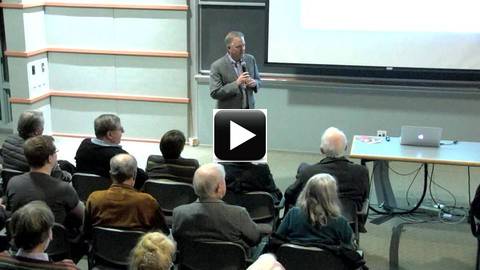|
Over the last few decades, string theory has emerged as a consistent,
unified quantum theory of all the particles and forces. This development
has led to a sharper understanding of the geometry of space and time as
well as the basic physical laws that govern that geometry. String theory
has also resulted in surprising predictions about our universe.
Solutions to string theory involve spaces with special mathematical
properties. The study of these spaces has led to a ‘landscape’ of
potentially consistent universes. The work has also led to the
unexpected result that some consistent-looking universes cannot possibly
exist and belong to the ’swampland.’ In this talk, Cumrun Vafa reviews
some of the predictions to which this picture leads, both for the
fundamental constituents of our universe as well as the ultimate fate of
the cosmos. |
 |
Cumrun Vafa is the Hollis Professor of Mathematicks and Natural
Philosophy at Harvard University. Born in Iran in 1960, he moved to the
United States in 1977 to receive his B.S. in Mathematics and Physics
from MIT before earning a Ph.D. in theoretical physics from Princeton
University.
Professor Vafa is world-renowned for his groundbreaking work in string
theory and the mathematical technology needed to explore the field. He
is one of the founders of the duality revolution in string theory, and
has uncovered mysteries of black holes using its topological aspects. He
is also the founder of `F-theory,’ which is one of the most promising
directions in connecting string theory solutions, known as the `string
landscape,’ to particle physics. This active area of research impacts
cosmology as well as particle phenomenology.
Professor Vafa has received numerous prizes and recognitions for his
work in theoretical physics including the 2017 Breakthrough Prize in
Fundamental Physics and the 2008 Dirac Medal of ICTP. He is a member of
the National Academy of Sciences as well as the American Academy of Arts
and Sciences. |

Intro by Mark Bowick |

![[01]](tn/01.jpg)
![[02]](tn/02.jpg)
![[03]](tn/03.jpg)
![[04]](tn/04.jpg)
![[05]](tn/05.jpg)
![[06]](tn/06.jpg)
![[07]](tn/07.jpg)
![[08]](tn/08.jpg)
![[09]](tn/09.jpg)
![[10]](tn/10.jpg)
![[11]](tn/11.jpg)
![[12]](tn/12.jpg)
![[13]](tn/13.jpg)
![[14]](tn/14.jpg)
![[15]](tn/15.jpg)
![[16]](tn/16.jpg)
![[17]](tn/17.jpg)
![[18]](tn/18.jpg)
![[19]](tn/19.jpg)
![[20]](tn/20.jpg)
![[21]](tn/21.jpg)
![[22]](tn/22.jpg)
![[23]](tn/23.jpg)
![[24]](tn/24.jpg)
![[25]](tn/25.jpg)
![[26]](tn/26.jpg)
![[27]](tn/27.jpg)
![[28]](tn/28.jpg)
![[29]](tn/29.jpg)
![[30]](tn/30.jpg)
![[31]](tn/31.jpg)
![[32]](tn/32.jpg)
![[33]](tn/33.jpg)
![[34]](tn/34.jpg)
![[35]](tn/35.jpg)
![[36]](tn/36.jpg)
![[37]](tn/37.jpg)
![[38]](tn/38.jpg)
![[39]](tn/39.jpg)
![[40]](tn/40.jpg)
![[41]](tn/41.jpg)
![[42]](tn/42.jpg)
![[43]](tn/43.jpg)
![[44]](tn/44.jpg)
![[45]](tn/45.jpg)
![[46]](tn/46.jpg)
![[47]](tn/47.jpg)
![[48]](tn/48.jpg)
![[49]](tn/49.jpg)
![[50]](tn/50.jpg)
![[51]](tn/51.jpg)
![[52]](tn/52.jpg)
![[53]](tn/53.jpg)
![[54]](tn/54.jpg)
![[55]](tn/55.jpg)
![[56]](tn/56.jpg)
![[57]](tn/57.jpg)
![[58]](tn/58.jpg)
![[59]](tn/59.jpg)
![[60]](tn/60.jpg)
![[61]](tn/61.jpg)
![[62]](tn/62.jpg)
![[63]](tn/63.jpg)
![[64]](tn/64.jpg)
![[65]](tn/65.jpg)
![[66]](tn/66.jpg)
![[67]](tn/67.jpg)
![[68]](tn/68.jpg)
![[69]](tn/69.jpg)
![[70]](tn/70.jpg)
![[71]](tn/71.jpg)
![[72]](tn/72.jpg)
![[73]](tn/73.jpg)

![[01]](tn/01.jpg)
![[02]](tn/02.jpg)
![[03]](tn/03.jpg)
![[04]](tn/04.jpg)
![[05]](tn/05.jpg)
![[06]](tn/06.jpg)
![[07]](tn/07.jpg)
![[08]](tn/08.jpg)
![[09]](tn/09.jpg)
![[10]](tn/10.jpg)
![[11]](tn/11.jpg)
![[12]](tn/12.jpg)
![[13]](tn/13.jpg)
![[14]](tn/14.jpg)
![[15]](tn/15.jpg)
![[16]](tn/16.jpg)
![[17]](tn/17.jpg)
![[18]](tn/18.jpg)
![[19]](tn/19.jpg)
![[20]](tn/20.jpg)
![[21]](tn/21.jpg)
![[22]](tn/22.jpg)
![[23]](tn/23.jpg)
![[24]](tn/24.jpg)
![[25]](tn/25.jpg)
![[26]](tn/26.jpg)
![[27]](tn/27.jpg)
![[28]](tn/28.jpg)
![[29]](tn/29.jpg)
![[30]](tn/30.jpg)
![[31]](tn/31.jpg)
![[32]](tn/32.jpg)
![[33]](tn/33.jpg)
![[34]](tn/34.jpg)
![[35]](tn/35.jpg)
![[36]](tn/36.jpg)
![[37]](tn/37.jpg)
![[38]](tn/38.jpg)
![[39]](tn/39.jpg)
![[40]](tn/40.jpg)
![[41]](tn/41.jpg)
![[42]](tn/42.jpg)
![[43]](tn/43.jpg)
![[44]](tn/44.jpg)
![[45]](tn/45.jpg)
![[46]](tn/46.jpg)
![[47]](tn/47.jpg)
![[48]](tn/48.jpg)
![[49]](tn/49.jpg)
![[50]](tn/50.jpg)
![[51]](tn/51.jpg)
![[52]](tn/52.jpg)
![[53]](tn/53.jpg)
![[54]](tn/54.jpg)
![[55]](tn/55.jpg)
![[56]](tn/56.jpg)
![[57]](tn/57.jpg)
![[58]](tn/58.jpg)
![[59]](tn/59.jpg)
![[60]](tn/60.jpg)
![[61]](tn/61.jpg)
![[62]](tn/62.jpg)
![[63]](tn/63.jpg)
![[64]](tn/64.jpg)
![[65]](tn/65.jpg)
![[66]](tn/66.jpg)
![[67]](tn/67.jpg)
![[68]](tn/68.jpg)
![[69]](tn/69.jpg)
![[70]](tn/70.jpg)
![[71]](tn/71.jpg)
![[72]](tn/72.jpg)
![[73]](tn/73.jpg)